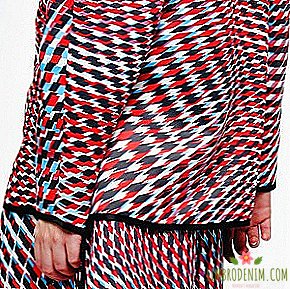Metamodernism in fashion: What it is and why everyone talks about it
"The irony works smoothly when you need to make us smile. But it is also capable of causing pain, because using such a tool it is easy to ask the most uncomfortable questions. I consider my main task to be trying to find the fine line that separates delicate irony from harsh sarcasm. "This free quote from the interview of Demny Gvasalia, which he gave to the fashionable media resource Vestoj in December 2017, quite accurately retells the key message of metamodernism - the concept that came to postmodern change.

In the Manifesto of Metamodernism, thanks to which, in 2011, the term was finally included in the media story, British artist and co-author of art works of Chailly Labaaf Luke Turner explained that society, tired of postmodern nihilism and nihilism, adopted a course towards “enlightened naivety and pragmatism and pragmatism of postmodern nihilism and pragmatic naivety and pragmatism and pragmatism.” .
Like the postmodern, metamodern is marked on the ruins of historical heritage, agreeing with the statement that all the best in the field of art (and fashion including) has been created in the past. But if the postmodernist method is based on destruction and malicious mockery, metamodernism is characterized primarily by empathy and careful rethinking of the “old testaments”.
With respect to fashion, the definition of "metamodernist" was first used in connection with the Prada advertising campaign of the fall / winter 2015/16 season. “Elegant and ironic chanting of metamodernist femininity,” the press wrote about the photographs of Stephen Meisel, who imprinted models on things that were borrowed from the closet of an exemplary Stepford wife. At the same time, despite the obvious retrovibes on the frames, there is not a single trace of mockery or hypertrophic comicness: this is not an evil cartoon or parody, but an elegiac photo reflection on the history of the women's issue from the perspective of modern man.


"Tastes differ". "Everything is relative". "There are no objective definitions of beauty and ugliness, holy and blasphemous." "There is no absolute right or wrong." "To a watermelon, and to whom the pig cartilage." Approximately such poster screams would be accompanied by an imaginary demonstration of adepts of metamodernism. And the farther, the more obvious that fashion becomes the dominant art in his era, and the main fashion metamodernists are the creative director of Vetements / Balenciaga Demna Gvasalia and the creative director of Gucci Alessandro Michele.
The work of each of them is an augmented reconstruction of the already existing aesthetics: Demna gives remixes to Marghela, and Alessandro - a potpourri on the Renaissance theme. Event and media contexts that are formed around the sponsored Gvasalia and Michele brands are sometimes more important than the things themselves, which adorn the cherished label: whether it is a collection of Gucci memes or a pop-up store with imitations of fakes Vetements things (just think) Official Fake in Seoul - these the phenomena will definitely be included in the fashion history textbook as reference samples of metamodern fashion marketing. From the conflict situations, the heroes of the new time come out, acting on all the canons of the very pragmatic idealism, about which Luke Turner wrote in his manifesto.
For example, six months ago, a scandal broke out, the reason for which were obvious borrowing from the heritage of the legendary Harlem tailor Dapper Dan in the Gucci cruise collection. And now, in May 2018, Depper's capsule collection for Gucci comes out, and Dan himself, with his unique creative vision, becomes an integral part of the brand. Cultural appropriation goes to a new level: we borrow, but carefully, with respect, admiring and admiring, rather than screaming and mocking, as in the postmodern era.


The most vivid illustration of fashionable metamodernism is the interest in reconstructed denim and vintage faces, which over the past couple of years have become the object of intense fashion hunting. And of course, this is exactly Gvasalia, as part of his work at Vetements - who did not dream of these jeans, which were redrawn into new styles with open pockets - also had a hand in popularizing this phenomenon.
Demne and Alessandro have one more interesting feature: it is never clear - whether they are all serious, or they are foolish. However, this ambivalent feeling is also characteristic of the activity of other bright metamodernists working in adjacent directions: be it Virgil Ablo, Gosha Rubchinsky, Shia Labaf with his status as a fashion icon and art activity or Kanye West in all his roles.
The thing is that, according to the same postulates of metamodernism, there is no clear distinction between "seriously" and "jokingly", all meanings and intentions are read at the same time as real, as ironic, as opposed, and as related. Shia is the most fashionable, exactly because it does not at all strive to be fashionable. And the Balenciaga bag, which imitates the Ikea package, does not look like a mockery at the convinced fascist, because it was invented by Gvasalia primarily as a functional accessory that fits well into the modern urban environment.

“Although Vetements already existed as a serious brand, I still still had the opportunity to hang out a lot,” Demna said in the above-mentioned interview. “I almost always dressed in the uniform of the guards, not for the sake of courage, but simply because such clothes opened all the doors and I could go to any club and to any party. I never stood in a line and never paid an entrance fee. "
It is customary to hear how the adherents of the old, “real” fashion of the Pre-Rumanian time complain that the designers-creators are no longer in high esteem, they work on collections as stylists. Indeed, fashion brands today for the most part do not sell specific things, but the atmosphere, spirit, and involvement. But this aesthetic relativism also turns out to be a fairly clear marker of metamodernism: appeal to personal, sensual forms public opinion and consumerist inquiry much more effectively than objective facts and material objects.
The quiet marketing revolution carried out by the Calvin Klein 205W39NYC brand under the guidance of Raf Simons is very revealing. In the pictures of the campaign for the fall / winter 2017/18 season, along with the things of the new, advertised collection appear, albeit in the distance, in the background, things from the previous one. This unprecedented and for some reason remaining almost unnoticed technique quite exhaustively documents the next stage of development of fashion marketing: revisiting (not to be confused with vintage) officially becomes an important component of metamodernist fashion and we will have to dig into this not so much the long archives of Prada, Helmut Lang or Martin Margiela.
Neologomania, erosion of gender in fashion and its pornification, destruction of the institute of luxury and luxury, street style hegemony and the phenomenon of instamodels in defiance of the cult supermodels of the 90s, democratization of political fashion — dwell on all aspects and subtleties of the manifestation of metamodernism in modern fashion, is hardly likely will succeed. And this fashion show goes on.
Photo: Gucci, Prada, Balenciaga, Calvin Klein





